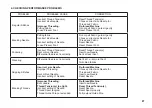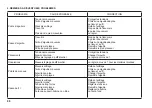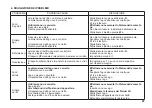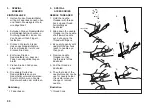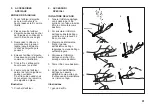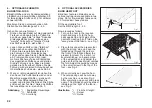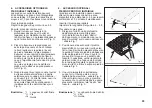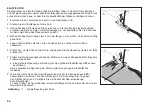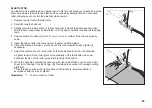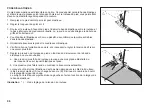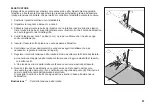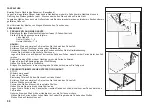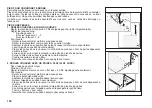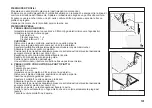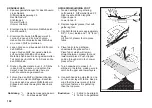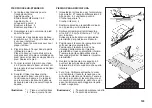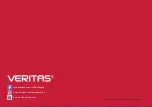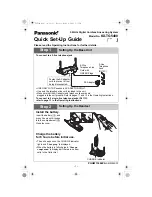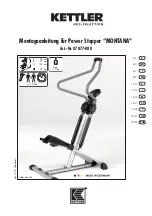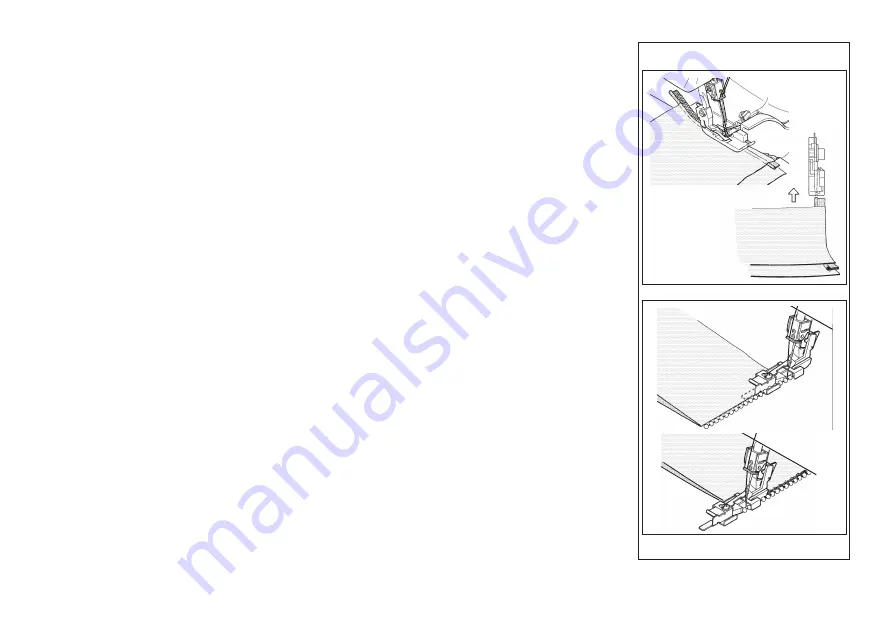
101
PIPING FOOT
Prepare a piece of ready-made piping (corded bias fold tape).
Place folded piping between seam edges with fold extending
beyond seam line toward garment. Pin or baste, and stitch the
seam.
Braid or ribbon may also be used, either flat or folded braid can
be used in straight seams.
Use for decorating edges of collars, cuffs, pockets, etc.
P
P
E
E
A
A
R
R
L
L
F
F
O
O
O
O
T
T
1. PEARLS ALONG AN EDGE:
Set for left needle (remove right needle) 3-thread overlock.
Set tensions as follows:
Left needle: 4
Upper looper: 1 - 2
Lower looper: 7 - 8
SEW:
࣭
Remove regular foot; replace with pearl foot.
࣭
Remove stitch finger as you did for a rolled edge.
࣭
Swing cutter away to lowest position, close front covers.
࣭
Raise the needle to it's highest position.
࣭
Place pearls in the channel on the right side of the foot
with 2" of pearls extending behind foot.
࣭
Take one stitch with the hand wheel to secure the pearls.
࣭
Follow edge of fabric along fabric guide.
࣭
Sew pearls on edge of fabric.
࣭
Return cutter to original position when finished.
2. PEARLS SEWN WITH A FLAT LOCK STITCH:
FABRIC:
Medium weight woven
2 or 4 mm pearls
Set for a 3-thread flat lock, left needle only. See pg. 28
SEW:
࣭
Remove regular foot; replace with pearl foot.
࣭
Insert small stitch finger.
࣭
Swing cutter away to lowest position.
࣭
Raise needle to it's highest position.
࣭
Place pearls in channel on right side of the foot with 2" of
pearls extending behind foot.
࣭
Take one stitch with the hand wheel to secure the pearls.
࣭
Sew pearls on with the left needle just catching the fold of
the fabric.
࣭
Pull flat lock open.
P
P
I
I
E
E
D
D
P
P
O
O
U
U
R
R
C
C
O
O
R
R
D
D
O
O
N
N
N
N
E
E
T
T
E
E
N
N
R
R
O
O
B
B
E
E
Permet de confectionner un bord avec un cordonnet enrobé.
Plaçer le bord de façon à ce que le bord enroulé soit plaçé hors de la
couture. Bâtir ou épingler, puis coudre. Toutes les sortes de cordons
plats ou pliés peuvent être cousues en un seul surfilage droit. On peut
aussi utiliser des franges ou des rubans.
S'utilise pour réaliser des bords décoratifs pour les cols, poches,
côtés des trainings ou fuseaux, etc ...
P
P
I
I
E
E
D
D
P
P
O
O
S
S
E
E
P
P
E
E
R
R
L
L
E
E
S
S
1. PERLES COUSUES LE LONG DU SURJET:
Régler la machine pour l'overlock à 3 fils et aiguille gauche (retirer
l'aiguille droite).
Régler les tensions ainsi:
Aiguille gauche: 4
Boucleur supérieur: 1 - 2
Boucleur inférieur: 7 - 8
Pour coudre:
࣭
Retirer le pied normal et mettre le pied pose perles.
࣭
Retirer le doigt-mailleur comme pour faire un ourlet roulotté.
࣭
Abaisser le couteau en position basse (sans coupe) et refermer
le capot latéral.
࣭
Lever l'aiguille en position haute maximum,
࣭
Plaçer les perles dans le canal sur le côté droit du pied avec 2"
de perles dépassant derrière le pied.
࣭
Faire un point en tournant le volant à la main afin de prendre les
perles.
࣭
Suivre le côté du tissu avec le guide-tissu de la machine.
࣭
Coudre les perles le long du tissu.
࣭
Remettre le couteau en position de coupe après ce travail.
2. PERLES COUSUES AVEC UN POINT A PLAT (FLAT LOCK):
Tissu: lainage de poids moyen
Perles de 2 ou 4 mm.
Régler la machine comme pour un
Ӑ
flat lock
ӑ
à 3 fils, aiguille
gauche seulement.
Pour coudre:
࣭
Retirer le pied normal et mettre le pied pose perles.
࣭
Plaçer le petit doigt-mailleur (B).
࣭
Abaisser le couteau en position basse (sans coupe).
࣭
Relever l'aiguille en position haute maximum.
࣭
Plaçer les perles dans le canal sur le côté droit du pied avec 2"
de plus dépassant à l'arrière.
࣭
Faire un point en tournant le volant à la main afin de prendre Ies
perles.
࣭
Coudre les perles avec l'aiguille gauche attrapant juste le repli
du tissu.
࣭
Tirer le
Ӑ
flat lock
ӑ
pour ouvrir.
࣭
Remettre le couteau en position haute (coupe) après ce travail.
PIEDINO PER PROFILI
Preparare un pezzo di profilo già pronto (nastri piegati con cordoncino).
Posizionare un profilo piegato tra i bordi della cucitura con la piega che sporge oltre la linea di
cucitura in direzione dell’indumento. Spillare o imbastire ed eseguire un punto sulla cucitura.
Si possono usare anche trecce o nastri, nelle cuciture dritte si possono usare sia le trecce
piatte che piegate.
Usarle per decorare i bordi di colletti, polsini, tasche, ecc.
PIEDINO PER PERLE
1. PERLE LUNGO UN BORDO:
Impostare la macchina per un overlock a 3 fili con l’ago sinistro (rimuovere l’ago destro).
Impostare le tensioni come segue:
Ago sinistro: 4
Crochet superiore: 1 - 2
Crochet inferiore: 7 - 8
CUCITURA:
Rimuovere il piedino ordinario, sostituirlo con quello per perle.
Rimuovere la guida del punto come per un bordo arrotolato.
Spostare il coltello fino alla posizione più bassa, chiudere i coperchi dei crochet.
Sollevare l’ago fino al punto più elevato.
Posizionare le perle nella scanalatura presente sul lato destro del piedino lasciandole
sporgere dietro al piedino per circa 5 cm.
Eseguire un punto con la manopola per fissare le perle.
Seguire il bordo del tessuto lungo la guida.
Cucire le perle sul bordo del tessuto.
Una volta terminato, riportare il coltello nella sua posizione iniziale.
2. PERLE CUCITE CON CUCITURA A PUNTO PIATTO:
TESSUTO:
Tessuto di peso medio
Perle da 2 o 4 mm
Impostare un punto piatto a 3 fili, solo con l’ago sinistro.
Rimuovere il piedino ordinario, sostituirlo con quello per perle.
Inserire una piccola guida del punto.
Spostare il coltello fino alla posizione più bassa.
Sollevare l’ago fino al punto più elevato.
Posizionare le perle nella scanalatura presente sul lato destro del piedino lasciandole
sporgere dietro al piedino per circa 5 cm.
Eseguire un punto con la manopola per fissare le perle.
Cucire le perle sul tessuto con l’ago sinistro che va a colpire solamente la piega del
tessuto.
Tirare la cucitura piatta fino ad aprirla.

